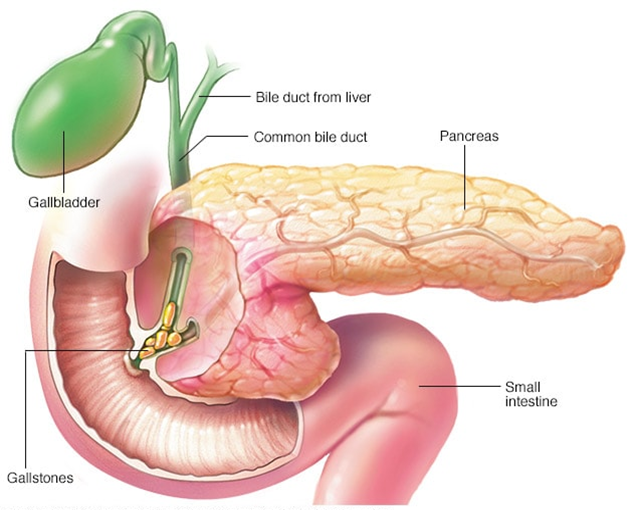Gallstones
What are Gallstones?
A pear-shaped organ below our liver located at the abdomen’s upper right side is called a Gall Bladder. Bile juice, which is responsible for breaking down fats, is stored in the gall bladder. The hardened or solid pieces of bile that are formed in the gall bladder are called gallstones.
What are the causes of gallstones?
When the cholesterol present in bile is too much and cannot be dissolved by enzymes, it converts into stones. Most of the gallstones are formed due to excess cholesterol. Gallstones can also be formed when bile has excess bilirubin. Also, if the gall bladder does not empty fully, it leads to stagnation and stone formation. The size of the gallstones can differ from a small seed to the size of a golf ball. Sometimes, the presence of gallstones would not be known until they block the bile duct. There are some risk factors like age, diabetes, obesity, a diet rich in fat and poor in fibre, a sedentary lifestyle, medication, problems in the liver, and genetics that can cause gallstones. Some of these factors are controllable, while others are uncontrollable.


What are the symptoms of gallstones ?
Sometimes, gall bladder stones may not exhibit any symptoms. Such cases are called silent or incidentally detected stones. When patients develop symptoms from gallstones, they are called symptomatic gallstones. Generally, patients with symptomatic gallstones have pain in the right side of the abdomen. This pain can be severe and may travel to the back or right shoulder. Such patients also experience heaviness in the abdomen, vomiting, and nausea that can be worsened by eating food.
Jaundice and high fever are caused when the stone slips into the bile duct (bile duct stones or choledocholithiasis). When the bile duct is blocked, the patient can develop serious complications if not treated in time. If bile duct stones block the pancreatic duct, it can lead to pancreatitis, i.e., the inflammation of the pancreas. Such patients experience abdominal pain, nausea/vomiting. In other cases, gallstones may block the small duct near the opening of gallbladder (cystic duct) leading to acute cholecystitis, i.e., infection and inflammation in the gall bladder. Again such patients experience pain, nausea/vomiting and fever. Rarely, gallstones may also lead to cancer in the gall bladder (cholangiocarcinoma).
What are the tests for evaluation of gallstones ?
A gastroenterology surgeon (GI surgeon), gastroenterologist or gastrologist performs a thorough physical examination for diagnosing gallstones. Diagnosis includes examining the upper right of the abdomen for tenderness or pain. The following tests can be conducted to confirm the analysis of the condition as suggested by a gastroenterologist/gastrologist/ gastroenterology surgeon.
Blood Test: Person’s blood is collected and tested to determine if there is any ongoing infection, pancreatitis, jaundice, etc.
Endoscopic Ultrasound Scan (EUS): Ultrasound is a commonly used test to examine the gall bladder. Endoscopic Ultrasound shows comprehensive images of the gall bladder and bile ducts. During EUS, the physician passes an endoscope, a thin and flexible tube, through the patient’s mouth and digestive tract. It displays symptoms of inflammation or blockage in the gall bladder. In this procedure, the images of internal organs of the body are created with the help of high-frequency sound waves. In the endoscopic ultrasound scan, gallstones present in the bile duct can be identified easily.
Magnetic Resonance Imaging (MRI) Scan: In this process, radio waves and strong magnetic fields are used to generate images of the gall bladder.
